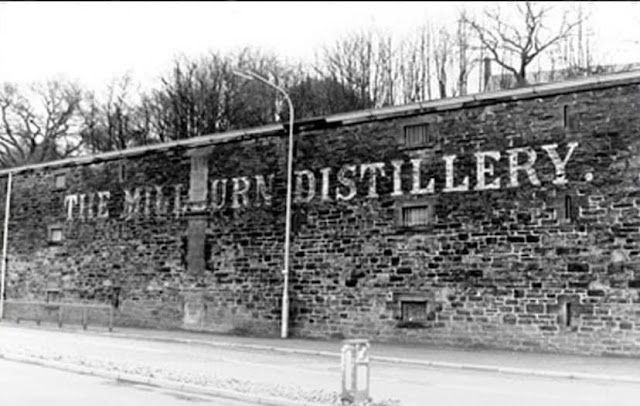Timeline
When bringing to life a distillery and its existence, a timeline is essential. This allows us to compare, contrast and debate. It also provides a detailed illustration of the life of the distillery; the important moments, the highs and lows. The character that you have in a glass.
This section of the website will be continuously updated. As new details come to light, they'll appear here and if you're reading this while seeking new information about Millburn distillery, I hope you enjoy the journey.
1805
Suggested first date of construction on the site.
1807
The distillery begins production.
1817
First official known date of a Millburn distillery with an Alexander McCallum & Co. the registered owners.
21st December 1825
Rose & McDonald Co. take ownership of the distillery.
1829
Rose & McDonald Co. are dissolved. Production continues under the name of the Millburn Distillery Co.
1829
New owners take over in the form of McDonald, Leslie & Co.
1832
McDonald & Co. take over the distillery.
1837
A Gordon Chisholm takes ownership for a short period.
1837
Production stops and the distillery is now called the Inverness Distillery.
12th August 1843
Several newspapers report the sequestration of Alexander MacDonald, distiller, Millburn.
1853
The site is taken over by David Rose, a local cereal merchant. The distillery is used as a flour mill for several years.
28th September 1876
Work is completed on the site and upgrade to a new distillery, with a local architect (Ross) overseeing the work.
1878
Received a substantial contract to supply the British Garrison in Cyprus.
1881
David Rose passes on ownership to his son, George.
1889
George Rose is listed as the owner and paying rent or the site is valued at £250.
1889
John Farquharson is appointed to be the distillery manager, leaving his previous post at Balblair distillery.
1892
George decides to sell up to A. Haig & Co.
1898
Capacity is increased.
16th October 1899
Millburn distillery commencing production for the new season with the price of whisky being 3s 3d.
1904
The name reverts back to the Millburn distillery.
1905
William Grigor is noted to be the distillery manager in the Inverness burgh directory and John Mackenzie is the head maltsman.
25th May 1907
The distillery places a notice in the Highland News warning of bottles that suggest they are from Millburn but are not pure malt.
18th May 1915
Millburn clerk, Peter Rose, dies in action in World War One.
1919
William Grigor remains as the distillery manager in the Inverness burgh directory.
1920
A new distillery manager is appointed with Mr J.A. Grant taking up the role.
31st January 1920
Confirmation that A.P. and D.P. Haig sold Millburn distillery on this date.
1921
The distillery is acquired to gin producers, Booth Distillery Ltd, who also have their own whisky blend. Millburn is referred to as Booth's Distillery in various entries in the Inverness Directory thereafter. This comes after the liquidation of the Sanderson family firm with the retirement of Mark Sanderson. The firm, as agreed, passed to Booth's with its new partners being Mr Bertram and Kenneth Sanderson.
26th April 1922
A famous fire breaks out on site and the local fire brigade is helped by the nearby Cameron Highlanders garrison. The warehousing and still house are saved.
1922
Charles C. Doig is employed to oversee the restoration of the distillery.
1925
John A. Grant continues to be listed as the distillery manager.
1931
Millburn distillery reopens following prohibition, as highlighted in this newspaper image from the period.
5th September 1932
Millburn is one of seventy-eight distilleries to close due to increase excise duty costs.
1935
Booth's Distilleries is incorporated with Bertram and chairman and Kenneth as director.
1937
The distillery is acquired by the Distillers Company Limited (DCL) and they would be the last owners until its closure.
9th February 1937
Former distillery manager, John Farquharson, passes away after an extensive business and distilling career.
1938
Kenneth Grant is listed as the distillery manager and lives at Dulnan Villa, Millburn Road. He also represents the distillery and distilling as part of the Inverness Chamber of Commerce.
1943
Ownership transferred to their sub-division known as Scottish Malt Distillers Limited (SMD). At the same time, Macleay Duff becomes the licensee of Millburn distillery. The Glasgow blender was acquired by DCL in 1933 for £325,000 and was originally founded in 1863.
1958
Converted to electrical power and the old steam engine that provided power to the malt mill, mash tun and tun rooms was removed.
16th October 1963
A cask provides the perfect setting for the distillery team photograph.
1964
Traditional floor malting is ended on site as Saladin Boxes are installed.
1965
Inverness Cream wins a diploma from the British Bottlers Institute for its flavour, quality and general excellence. The recipe itself is noted to be from the 1920.
1966
The Still House is rebuilt and in doing so, the stills are changed to indirect heating.
1970
The coal stokers are removed as oil heating is implemented.
1984
Saladin Boxes are closed and instead malting requirements are provided by the Ord site to the north of Inverness.
1985
Distillery is closed.
1988
This image taken by a local, shows the front end of the distillery site being demolished prior to any sale.
1990
The site is purchased by the Beefeater restaurant chain.



Comments
Post a Comment